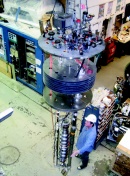Image of the week
|
|
Image: H. Hayano
At KEK's superconducting RF test facility, better known as STF, scientists are conducting beam tests of their photocathode RF gun towards beam operation of the accelerator for the Quantum Beam Project. On 22 March, scientists succeeded in the extraction of a 1-millisecond beam for a 162.5-megahertz bunch train. Pictured here is a signal from the beam position monitor (blue) and a laser gate signal (violet).
Read more about the Quantum Beam Project in a future issue of ILC NewsLine.
|
In the News
-
from CERN Courier
27 March 2012
The budget for the Department of Energy’s Office of Science would increase by 2.4 per cent to $4.992 billion, but high-energy physics would be reduced by 1.8 per cent to $777 million. …The proposed cuts in high-energy physics would hit two long-term programmes the hardest: the Long-Baseline Neutrino Experiment (LBNE) and the US R&D programme for the International Linear Collider (ILC).
-
from Nature
26 March 2012
Bill Brinkman, director of the DOE’s Office of Science, wrote to Oddone to ask that Fermilab build the LBNE in stages. “I would like Fermilab to lead the development of an affordable and phased approach that will enable important science results at each phase,” he wrote.
-
from Science Insider
22 March 2012
At a projected $1.5 billion, the Long-Baseline Neutrino Experiment (LBNE) at the Fermi National Accelerator Laboratory (Fermilab) in Batavia, Illinois, is not affordable, says William Brinkman, director of DOE’s Office of Science. So this week he asked physicists to come up with a cheaper way to do the same science.
Copyright © 2025 ILC International Development Team




